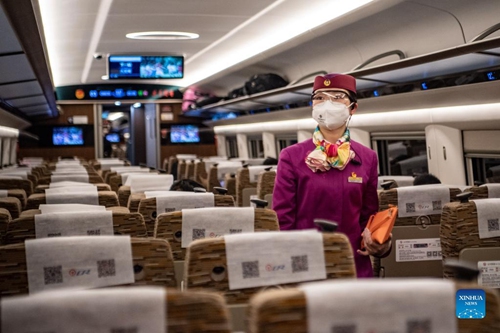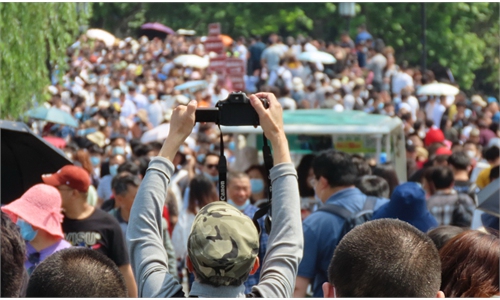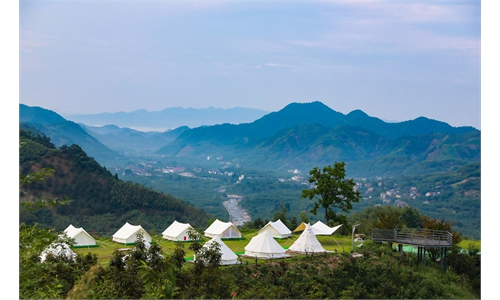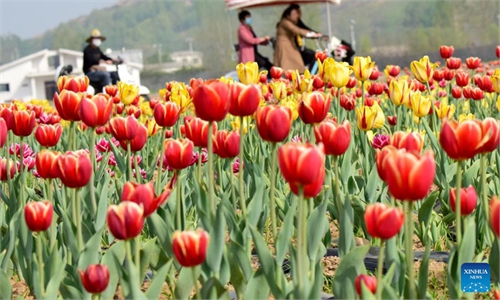Omicron dents prospects for travel during May Day holidays
Tourists expected to focus on intra-province sightseeing, short journeys

Lin Mengfan works aboard a Fuxing bullet train travelling on the Chendu-Chongqing Railway in southwest China, Jan. 27, 2022.(Xinhua/Tang Yi)
As multiple Chinese localities rolled out travel guidance for the upcoming five-day May Day holidays, asking residents to stay put and requiring nucleic acid test results, analysts said that the tourism sector is facing another test, with hopes of recovery dashed by the latest round of COVID-19 outbreaks.
However, there are still bright spots, as many are still planning to visit various places within their provinces or cities and engage in camping and other activities during holidays. Meanwhile, Chinese officials have also vowed to take various measures to boost consumption and support companies badly affected by COVID-19.
"Can I still join local tours?" and "Can I travel outside my home province?" were among the most discussed topics on China's Twitter-like Sina Weibo on Wednesday.
Usually a much-anticipated golden opportunity for tourism, this year's May Day holidays are overshadowed by the Omicron flare-ups. Local authorities are urging residents to stay put, as a travel rush could elevate the risk of virus transmission amid outbreaks seen in several Chinese cities.
Negative results of 48-hour nucleic acid tests are being required to enter South China's Hainan Province - a tropical tourist destination. Northwest China's Gansu Province has continued a ban on group travel and cross-province tours. Shenzhen temporarily suspended group travel to medium- and high-risk provinces, border port cities and outbound destinations.
Experts said that the latest COVID-19 outbreaks have dashed hopes for the domestic travel industry to regain some lost ground during the holidays.
"For an industry that has already suffered for nearly three years amid the epidemic, the [latest outbreaks and anti-epidemic measures] are a fresh blow," Zhang Lingyun, a professor of tourism development at Beijing International Studies University, told the Global Times on Wednesday.
"However, anti-epidemic efforts are top priority," Zhang said.
China's online travel booking platform Ctrip said that as of April 25, some 52 percent of the orders placed were for tourist sites within provinces during the holiday period.
For South China's Guangdong Province and Southwest China's Sichuan Province, such orders accounted for nearly 80 percent of all orders placed so far, according to Ctrip.
Although travel between provinces has become a luxury for many tourists, industry players said there is still a silver lining.
Tours to rural areas increased, with bookings for hotels in rural areas jumping to 560 percent of that of the Qingming Festival in April 3-5. Nearly 30 percent of the bookings are for family groups.
Travel platform Qunar.com said hotels in many cities are at their five-year-low for the May Day holidays, and many luxury hotels in Beijing, Chengdu in Southwest China's Sichuan Province, Southwest China's Chongqing municipality, Xi'an in Northwest China's Shaanxi Province, Hangzhou in East China's Zhejiang Province and Sanya in Hainan were only charging half the rates they had last year.
However, ticket sales for parks that can accommodate camping activity increased by 50 percent from last year's levels and camping-themed travel services saw bookings triple, according to Qunar.com.
Wang Ya, a resident of Chongqing, said camping grounds have to be booked a month in advance amid a surge of interest this year.
Data from flight data provider VariFlight sent to the Global Times showed that there has been a sharp rise in flight cancellations amid tightening epidemic control policies in the run-up to the May Day holidays, and flights during the holiday may drop to less than 3,000 a day, which would be a 70-80 percent drop from 2021 levels.
Provinces with all areas declared as low-risk areas are favored by tourists, and the current top three air routes are those between connecting Shenzhen, Chengdu, Chongqing and Sanya.
During the three-day holiday for the Qingming Festival, domestic trips were down 26.2 percent year-on-year to 75.42 million, or 68 percent of the 2019 level, official data showed on April 5.
Given the negative impact of the latest outbreaks on businesses, Chinese officials have rolled out various measures to boost consumption, including cash handouts and coupons, as well as policy support for businesses struggling to cope with disruptions. Experts expect a solid rebound in consumption once the outbreaks are brought under effective control soon.



